Business Features
Agent Capabilities
The embedded EFCX Connector runs within the Zoho CRM, enabling agents to handle calls and chats, including transfers, directly from the CRM interface.
It offers the following features:
Login to Agent Desk in Zoho CRM
An agent can be logged in by entering agent credentials and then pressing the ‘Login’ button from the login screen.
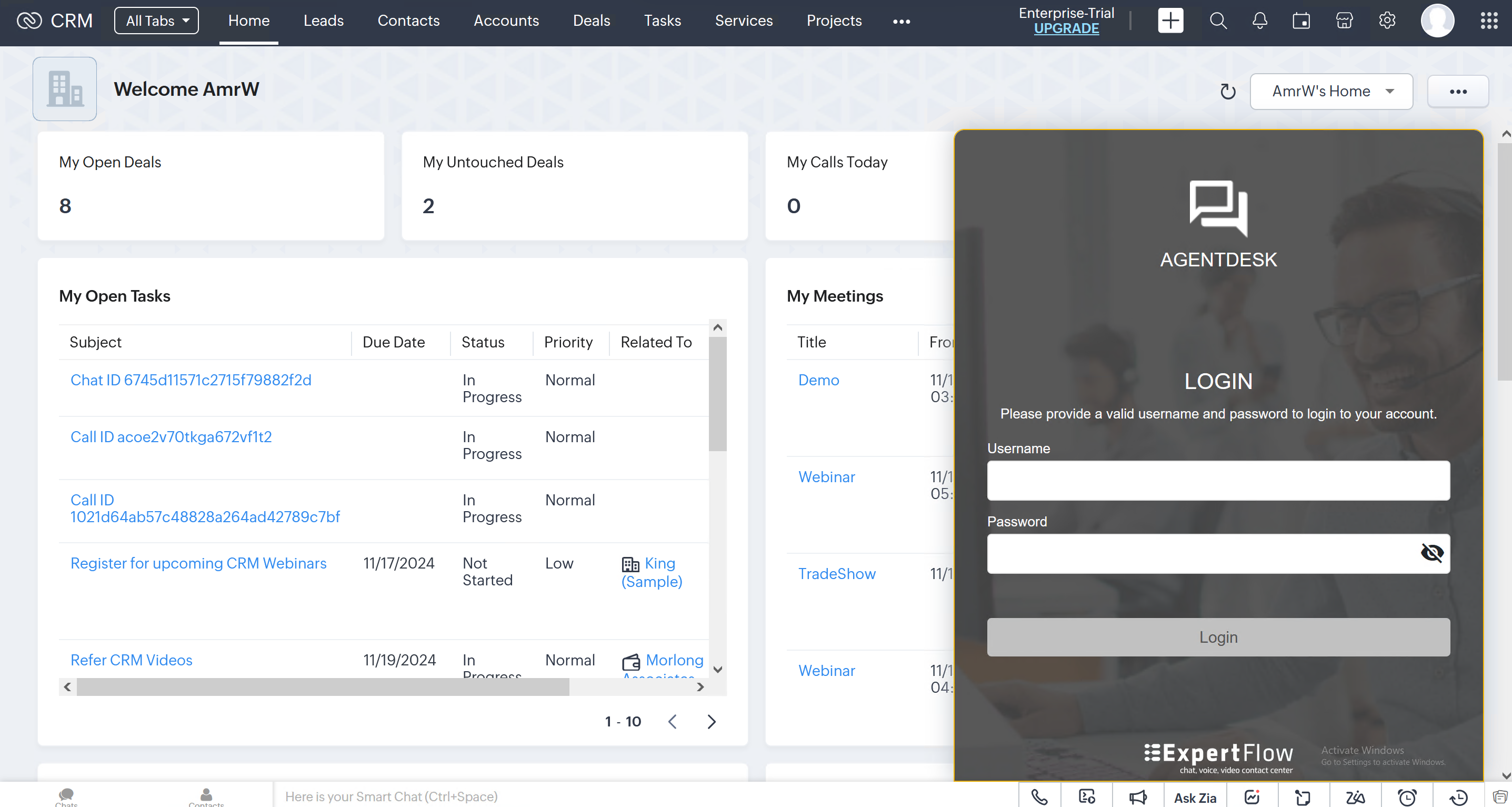
Login
Post Login Interface in CRM
After entering the credentials, the agent can see the Dashboard.
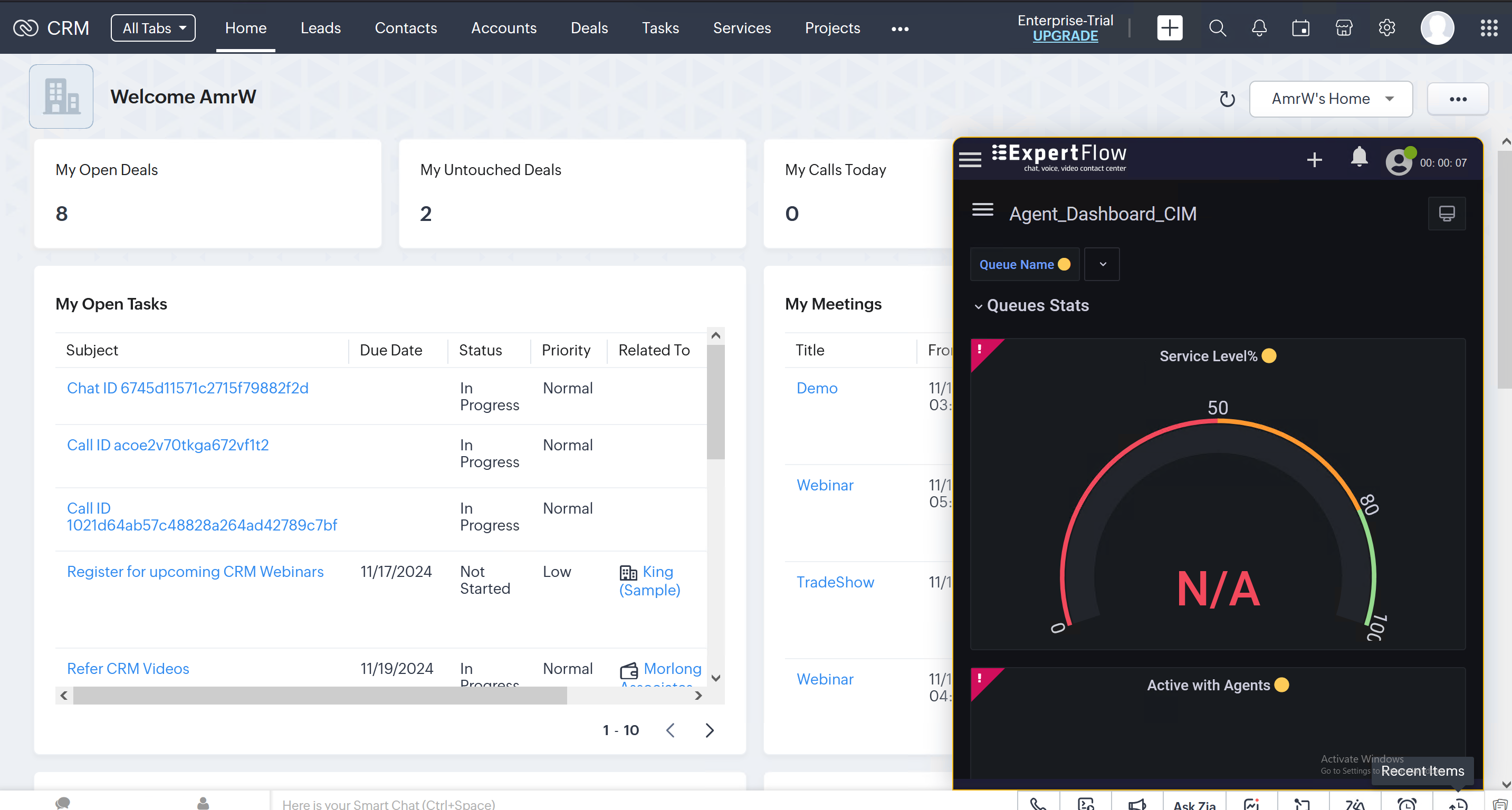
Post Login
State Change
Enables agents to change their states globally and MRD-wise.
Global State
Global states are the high-level states that serve as the basis for setting MRD states. The state change on this level affects state changes on all assigned MRDs.
Change Global state to Ready or Not-Ready
After logging in, an agent may change global state to Ready or Not-Ready.
During Wrap-up, an agent may change global state to Ready or Not-Ready.
Available controls for agent state are displayed when the bottom-facing arrow button is pressed.

Agent State
State Timer
Agents can also see the real-time timer going on to count how much time the agent remains in a state (Ready, Not Ready). This state timer is reset every time the global state is changed.

State time
MRD States
MRD states are specifically for a particular MRD. Once agents set themselves as Ready, or Not Ready on a specified MRD, they make themselves available or not available to take requests from that particular MRD.
Change CX Voice State to Ready or Not-Ready
After logging in, an agent may change the CX Voice state to Ready or Not-Ready.
On Ready state, he can be able to make inbound and outbound dialogs.

MRD States
Change Chat State to Ready or Not-Ready
After logging in, an agent may change the Chat state to Ready or Not-Ready.
On Ready state, he can be able to make inbound and outbound conversation.

Change state to Ready/Not-Ready
Logout
To logout, agent may select one of the logout reason that are displayed in the "Logout" section when he clicks on “Logout“ option. The agent will be logged-out with the respective reason.

Logout
Accept a Conversation
Enables agents to receive a conversation from queues, handle an ongoing conversation, link customer profiles, view conversation history, view active channels, and view conversation data.
Inbound Chat Notification
Once an agent receives a new request, it is assigned to an agent, and the agent is reserved. An incoming chat notification appears on the Agent Desk, with a button to Accept the request. The notification contains the name of the customer (if identified), or "Jane Doe".

Accept a Conversation
Conversation History
The Conversation History enables the agent to provide the record of all the conversations exchanged with the active customer. Each conversation carries activities exchanged over the conversation. These activities include:
Chat messages sent over the conversation (customer/whisper messages),
When the agent accepts the chat request from customer, he will land into chat screen where he can interact with the customer and can see the previous chats too.

Conversation History
Load More
By default, the past conversations are hidden behind a Load More button. If the agent has permission to load the history, can click this button to load the past conversations of the customer. To know about the latest query, go to the bottom of the conversation by clicking on Jump to bottom

Load the History
New Message
Upon receiving a new message while reading the previous history on the top, the agent will see the New Message button popping up. Click on that to read the newly received message.

New Message
Current Channel and Customer Profile
Upon accepting the requests, agents see the Customer Profile data and Media Channel details of the customer on the right under the relevant panes. The CRM profile of the customer is popped up in the background (CRM) as described in the Screen pop section .
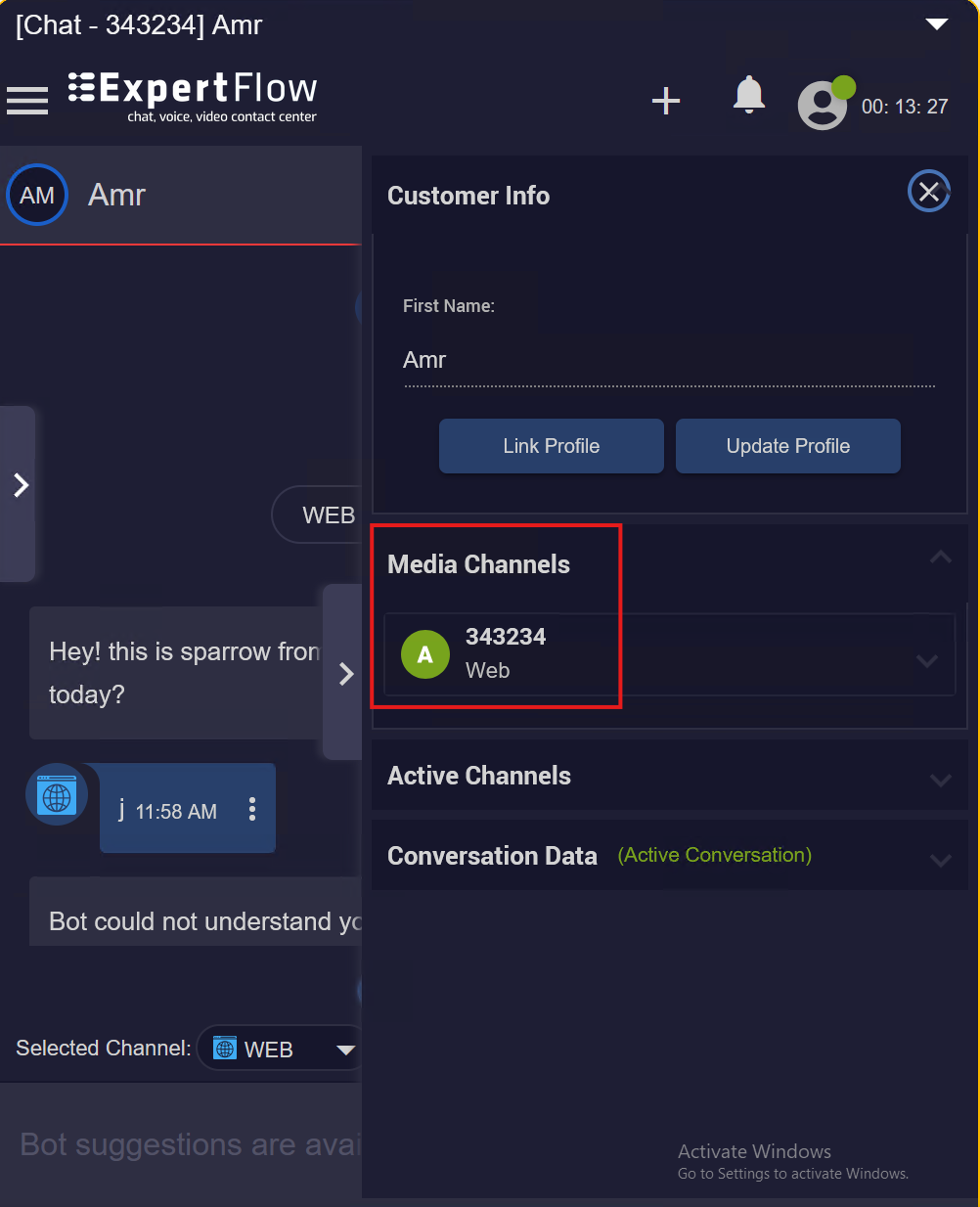
Current Channel and Customer Profile
Hold Conversation
The agent can hold the conversation while interacting with the customer.
Agent can hold the conversation for (1,3,5) minutes up to his requirements.

Hold Conversation
End Conversation
Based on agent permissions, an agent may leave an ongoing conversation even if a customer is present in the conversation.
If the agent leaves a conversation while the customer is still present on any of the customer channels, the conversation remains active but the agent task is closed.
If the agent leaves a conversation when the customer has left, the conversation is usually closed.
Click the 'cross' icon to leave the conversation. Upon clicking this icon.
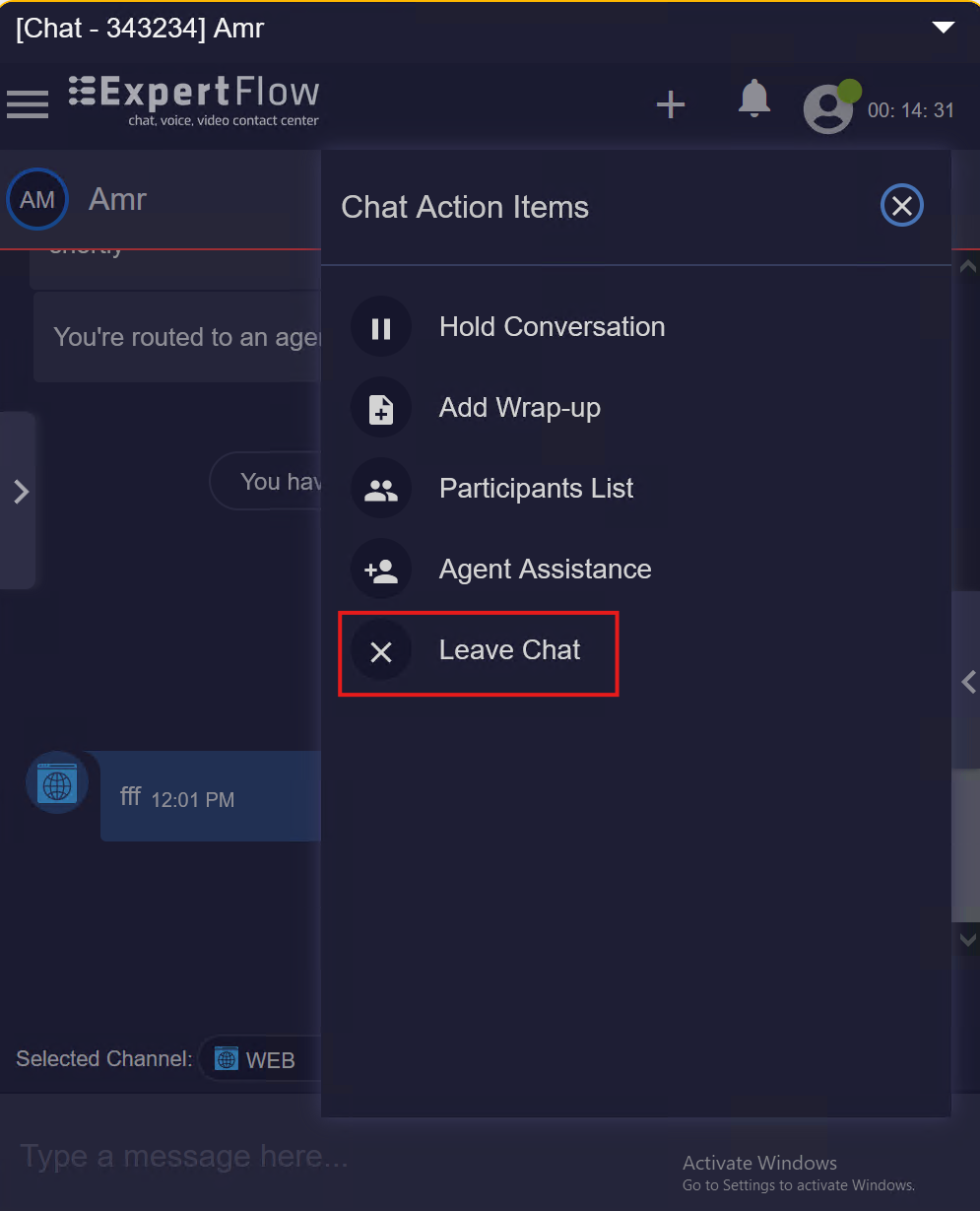
End Conversation
Apply Wrap-up and Add Notes
A wrap-up is a concluding note added to the conversation that helps the business to know what the conversation was about. Expertflow CX agents can provide wrap-ups to conversations that they handle, during or after the conversation.
Apply Wrap-up
Agents can Apply wrap-ups to a conversation by clicking the notes icon on the control toolbar. A wrap-up dialogue box will appear where wrap-up categories and reasons are listed as defined by the system administrator. The agent will choose a category and a reason that best matches the conversation with the customer.

Wrap-up and Notes
Add Notes
After applying wrap-ups, agents add notes to summarize what the conversation was all about. The wrap-up and notes in the conversation are available as independent activities in the Conversation view.
Wrap-up Timer
A wrap-up feature is already there in the application but it is not time-framed
CX now introduces a wrap-up timer as an important metric to measure the agent’s productivity. This feature limits the agent to wrap up the conversation within the configured time. The system shows a timer to the agent to wrap up the current conversation within the configured time.
The wrap up time is configurable. By default, it is set to 60 seconds.
The admins can define Wrap-up reasons as defined in the unified admin

Wrap-up Timer
Workflow
Whenever a conversation is closed from either side, a wrap-up window pops up. The wrap-up timer can be seen on the right-hand side. Pre-defined wrap-up reasons are displayed here. The agent can choose any suitable reason fit to the conversation and add notes as adding a note is optional.
If the agent leaves without adding the wrap-up, the timer will disappear/expire, the conversation will be automatically closed without any Wrap-up reasons as it is still optional.
Chat Switching
An agent can accept more than one conversation requests at a time. It means he can handle multiple conversation and can switch between different conversation by clicking on left under the relative panel.
In case of multiple conversations, when an agent switches to another conversation the customer profile in the CRM is also switched to the active conversation.

Chat Switching
CTI Call Controls
Provides a CTI toolbar for the agent to perform multiple functions to handle the customer calls.
Inbound Call notification
Once an agent receives a new request, an incoming call notification appears on the Agent Desk, with a button to Accept the request. The notification contains the number of the customer.

Call Controls
On accepting a call, the CTI toolbar appears with the following controls:
Drag
Mute/Unmute
Hold/Resume
End Call
Drag
As the agent accepts the call, the CTI toolbar pops up anywhere on the screen. On clicking this drag option, this toolbar can be moved any where on the screen.
Mute/Unmute
The Mute/Unmute button on the toolbar enables the agent to mute or unmute if and when required.
Call Hold/Resume
The agent can hold the call by clicking on the Hold button on being active on a call with the customer or with any other agent in case of transfer.
In the same way, the agent can resume the call by clicking on the Resume button as soon as becomes available again.
End Call
The agent can end the call using this toolbar by clicking on the End Call button. This will end the call leg between the agent and the customer.
.png?inst-v=95fc96d2-fa45-4b05-87fb-29296f213a7f)
Call controls appearance
Outbound Call
The agent can make an outbound call by clicking on dial pad on the dashboard.

Outbound call
Screen Pop
When a call or chat arrives on the logged-in agent, a CRM customer record is popped up according to the caller number and information stored in Zoho.
By default entities supported for searching are Account/Contact/Lead (we can set priority in configuration)
If one record is matched, then that record will automatically pop up.
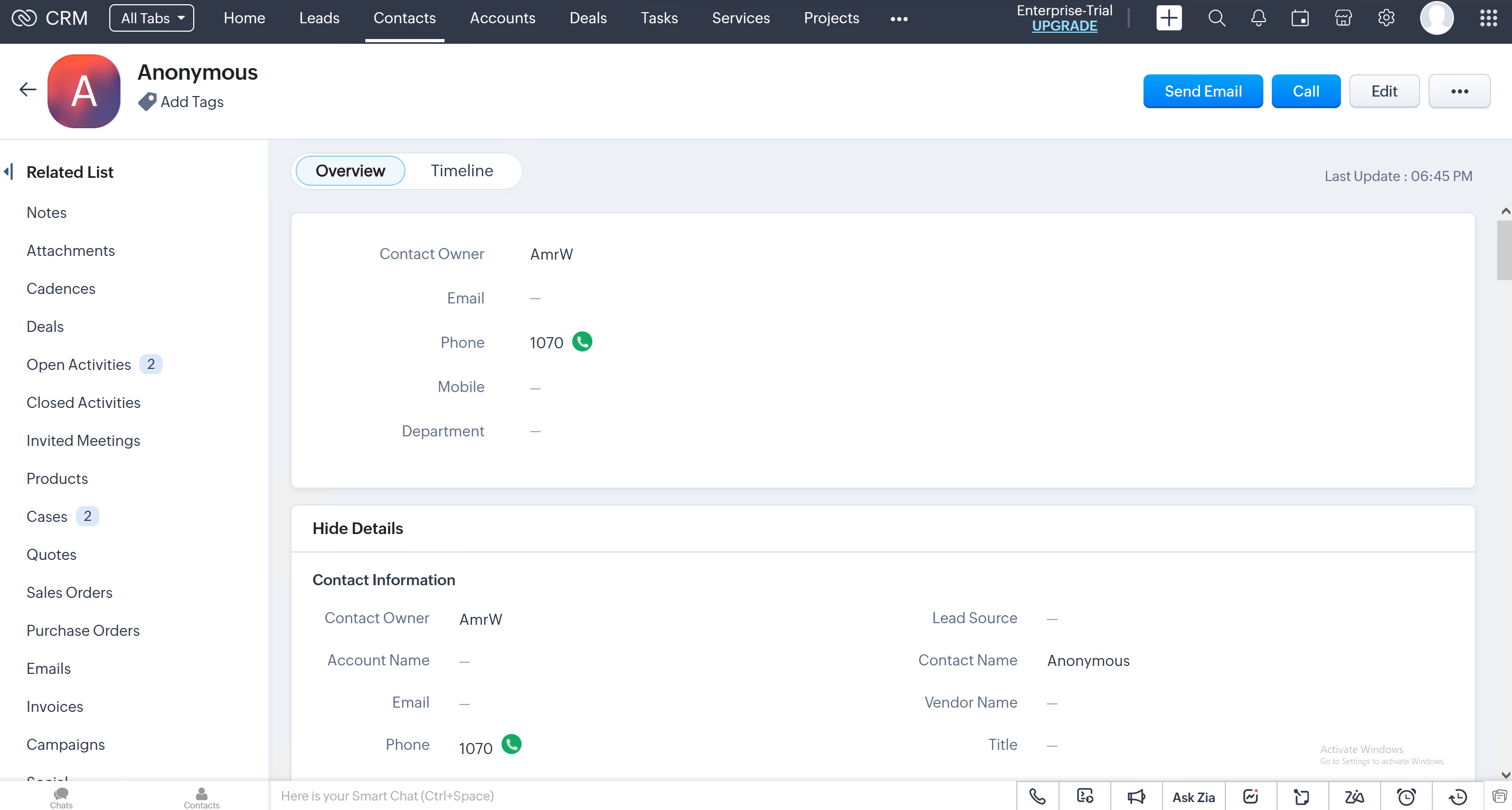
CRM Screen Pop
No ANI Match
If there is no match, a Contact will be saved with the name set to ‘Anonymous’, and the number set to the caller number. (By default for the No-Match case we create the Contact, however this is a configurable option and the user can change it as per his requirement).
We can configure the No-Match-Entity to account/contact/lead.

No Match ANI Screen Pop-up
Multiple Match
In the case of multiple matches, a list of all the matched records of the respective entity will be shown in the drop-down list in alphabetical order on the top of connector. The first record in the list will automatically pop up, however, the agent can also manually select the customer record from the dropdown list and that customer profile will pop up.

Multi-match ANI Drop-down list
Conversation Activity
A call/chat activity is created at the end of the conversation for all call & chat types except consulting calls. It contains information such as
Subject
Contact / Related To
Status
Priority
Created By
Time
Duration
Agent name
Conversation Direction
The task subject is created as a combination of different attributes that are conversation type and the ID.
All Call/Chat activities can be seen from the ‘Tasks’ tab at the top, it will show the activities in descending order i.e. latest activity will be at the top. In the case of single matching or no matching record, it will be created automatically.
Wrap-up reason and call notes will not be reflected in the call activity right now.

Conversation Activity
Click to Call
This feature allows the agent to select any number corresponding to a record (Account/Contact/Lead) and initiate an outbound call with that number.
Limitation
In the click-to-dial feature, for transferring the call (on Queue/Direct) to Agent “B”, we need to manually set the destination number in the configuration.
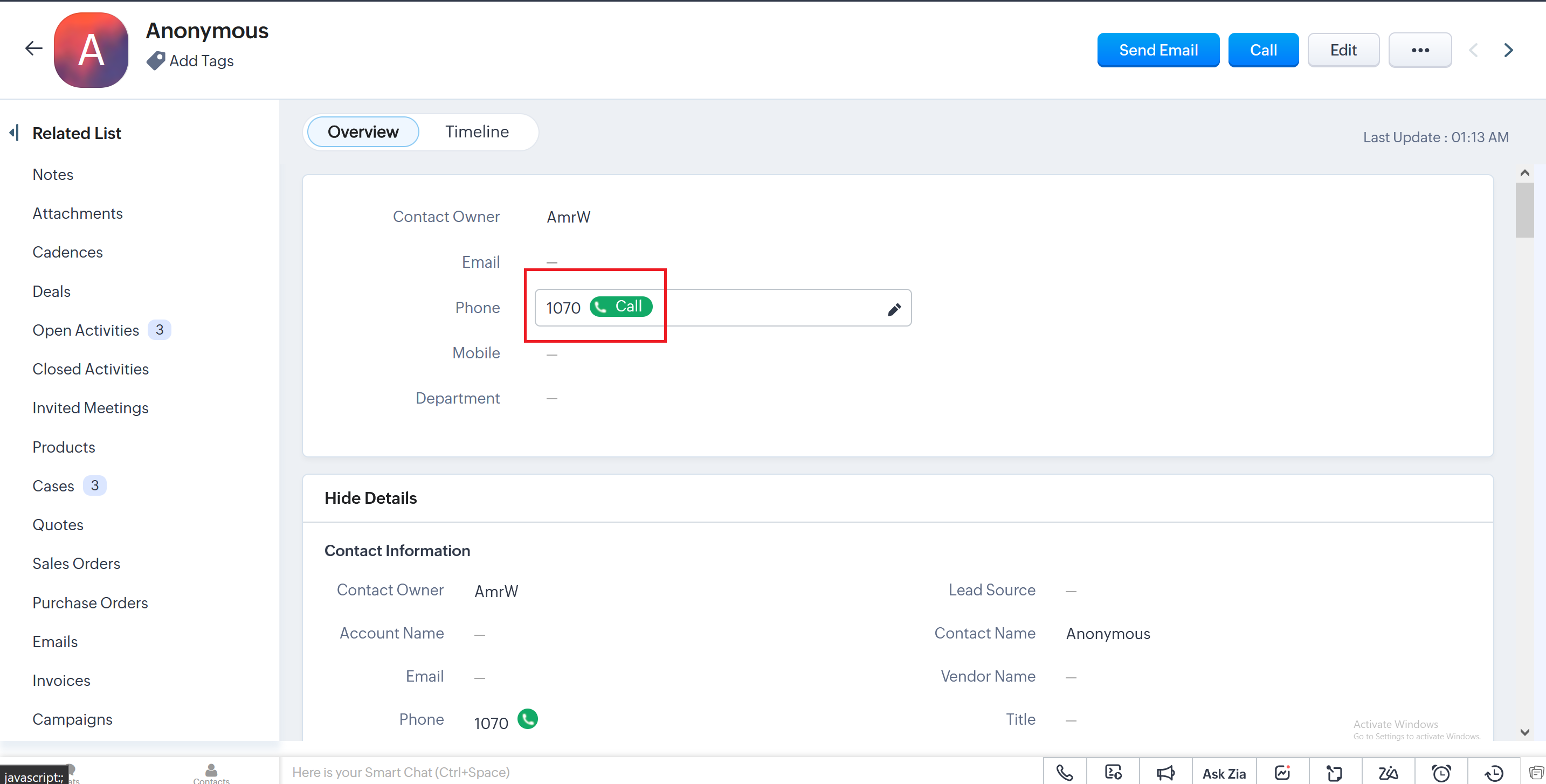
Click to Call
Silent Monitoring
Enables a supervisor to silently monitor an ongoing conversation between the agent and the customer.
In order to perfrom silent monitor, we need to do the following steps:
Open the left menu
Hover over the “Dashboard”
Choose “Ongoing Conversations Detail”
.png?inst-v=95fc96d2-fa45-4b05-87fb-29296f213a7f)
Silent Monitoring
Barge-In
While monitoring the conversation, if required, supervisors can barge into the conversation.
In order to start barge, we need to do the following steps:
Open the right menu
Choose “Barge In”

Barge-In
Whisper
While monitoring the conversation, supervisors can exchange whisper messages with the agent to assist them without the customer knowing.
In order to send a whisper message, we need to do the following steps:
Open the right menu
Choose “Whisper”

Whisper
